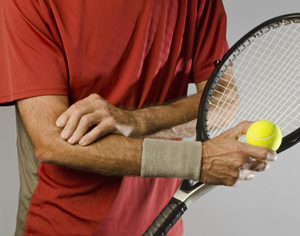Athlete’s Edge Series: How To Avoid Tennis Elbow

As summer heats up, tennis season is bringing more people to the court. While tennis is a great sport and can be a lot of fun, there are certain tennis-related injuries that are common among athletes. Learning about common injuries and conditions that happen during tennis can help you understand how to prevent them and how to treat them if you begin to experience symptoms.
What is Tennis Elbow?
Overusing the muscles located in the forearm can lead to inflammation in the tendons, known as tennis elbow. This condition is typical of tennis players that overextend during their swing or use poor technique when executing their backhanded swing. Any repetitive arm or wrist motion can result in tennis elbow.
Tennis elbow usually presents with lateral elbow pain where the wrist muscle attaches to the elbow. Arm pain during or after a tennis session can also be caused by incorrect grip on the racket, playing too frequently, poor shoulder rotation, and so forth. If you experience symptoms of tennis elbow, make sure to stop playing immediately and rest your arm. If you feel any acute pain, use ice for instant relief. If your symptoms persist or worsen, contact an orthopedic surgeon to evaluate the elbow to ensure that there is no lasting damage.

Identifying Typical Injures Associated with Tennis
In addition to tennis elbow, athletes can also experience shoulder pain or strain from persistent and frequent matches. For players that are younger than age 40, the common cause of pain is a labral tear, whereas for players older than 40, a rotator cuff injury is typical. If you have persistent shoulder pain, make an appointment with your doctor to have the injury evaluated.
In addition to shoulder injuries, tennis players can also experience abdominal and knee injuries. Be on the lookout for any signs of overexertion or tension in the abdominal muscles from frequent twisting during serves. ACL injuries are also typical for tennis players, as well as meniscal tears and an aggravation of the player’s arthritis. In order to prevent these injuries, build your muscle strength and listen to your body. Make sure to take enough time between sessions to allow your body to heal.
Injury Prevention Strategies
A targeted exercise program can help you build strength, improve endurance, and increase your overall level of health, which can also help you prevent injuries. Focus on strengthening your muscles, improving flexibility, and perfecting your technique in order to avoid injuring yourself while playing tennis.
